“All truly great thoughts are conceived while walking.” ∼ Friedrich Nietzsche, Twilight of the Idols
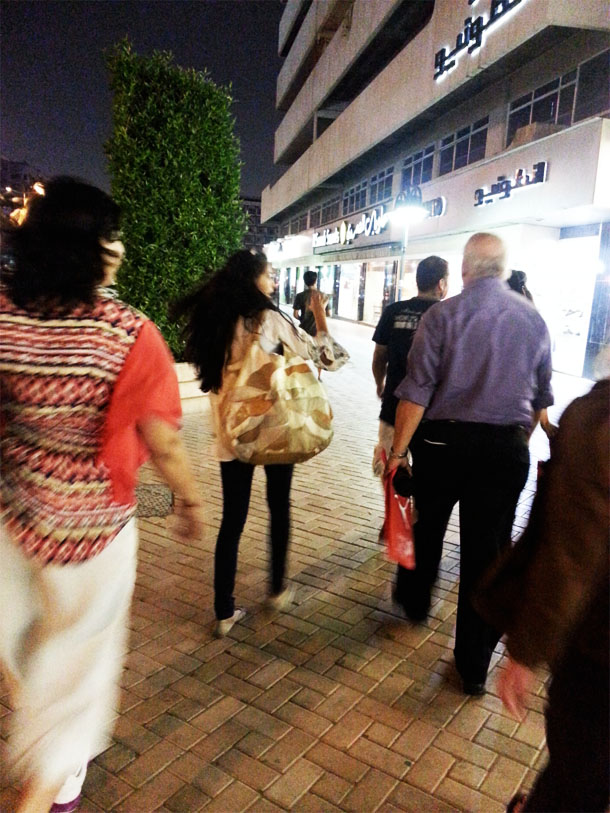
Culinary journeys and food tours reflect culture, heritage and personality of a city…
I am fascinated by street food and culinary journeys that expose me to different cultures and cuisines. The history behind these leave me breathless as I try to store new food facts in my memory. Naturally, my first food tour with Frying Pan Adventures, the only food tour company offering such tours in Dubai, is something that is close to my heart. I had been following food blogger Arva Ahmed’s journey even before she had set up tours in a city that is mostly associated with bling and glamour, rather than excursions into alleys in the old parts of Dubai. It is here that a treasure chest of culinary experience and gastronomical thrill awaits the tourist. Today, in many cities, food tours are as popular as sight-seeing tours.
Culinary tourism or food tourism – experiencing the food of a country, region or area, is now considered a vital component of tourism experience. Dining out is common among tourists and ‘food is believed to rank alongside climate, accommodation, and scenery’ in importance. The World Food Travel Association (WFTA) defines Food tourism as the pursuit of unique and memorable eating and drinking experiences. Interestingly, culinary or food tourism does not imply gourmet food. And according to WFTA, gourmet comprises only 8.1% of culinary travelers.

The Arabian Pilgrimage Food tour – my first food tour in Dubai
Our meeting point of the evening was in front of the Philippine Supermarket on Muraqqabat Street in Deira. I was accompanied by my friend Mamta, who I considered a ‘neutral’ companion. Being neutral meant that though she was a big foodie, she was new to Dubai (a few days old in Dubai at the time of our food tour) and had never read any blog posts written by me or Arva (and probably any blog for that matter). It also meant that she was completely unbiased and was expected to judge the food tour from the value for money aspect of a prospective tourist as well as a Dubai resident. I trusted her to act as an honest judge in our adventure. As for me, I was already starting the tour with a bit of bias – because of my belief in the concept of a food tour and the novelty of such an activity being offered in Dubai, a multi-cultural and an otherwise tourist frenzy city boasting of loads of things to do. Plus, I loved reading Arva’s blog, knew a bit of the behind-the-scene stories and had read up on a lot of good reviews on her tours. My expectation was sky high, so was my excitement.
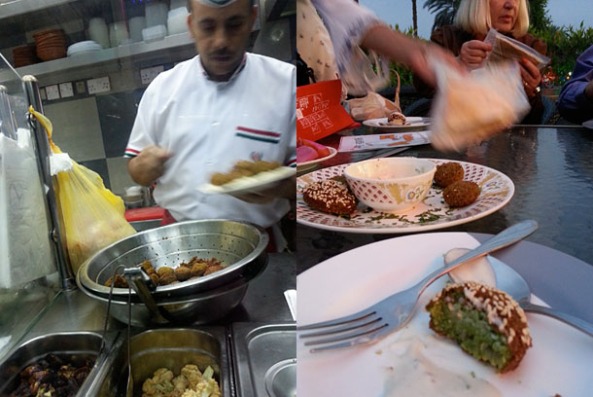
Falafel Mahshi and Hommous @Sultan Dubai Falafel
In the course of the evening, Mamta and I were joined by six other members and the eight of us strutted behind Arva like ducklings following a Mother Duck as she goes on a food rampage. Our first stop was Sultan Dubai Falafel where we got a small lesson and mini demonstration of Falafel making (above left and in the video below). We parked ourselves in the outdoor seating on the boulevard outside its adjoining Palestinian restaurant, Qwaider Al Nablusi. First, came the normal Falafels and then came the showstopper Falafels – the Falafel Mahshi – all from the Sultan Dubai Falafel restaurant. The ornate looking Falafel Mahshi (further below) is not the regular Falafel. Here, the Falafels are stuffed with chickpeas (like any other Falafel), coriander, parsley and lined with chilli, onions and Sumac (a very popular spice used in the Middle-Eastern dishes, that is often used as a substitute for lemons). Then these are deep fried and studded with sesame Seeds. What an amazing rendition of Falafels! These were accompanied by a yogurt and a Tahini (an oily paste made from ground sesame seeds) dip as well as the Hommous, the traditional Middle Eastern dip made with chickpeas. Till now, I had always referred to the Hommous as ‘chickpea Hommous’. Arva corrected me – remove the word chickpea before hummous, because it’s like saying ‘chickpea chickpea’!
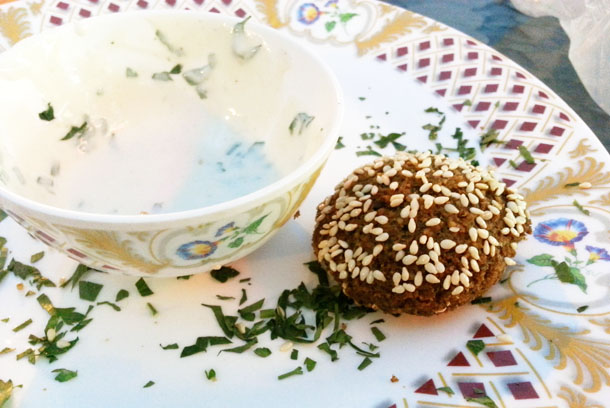
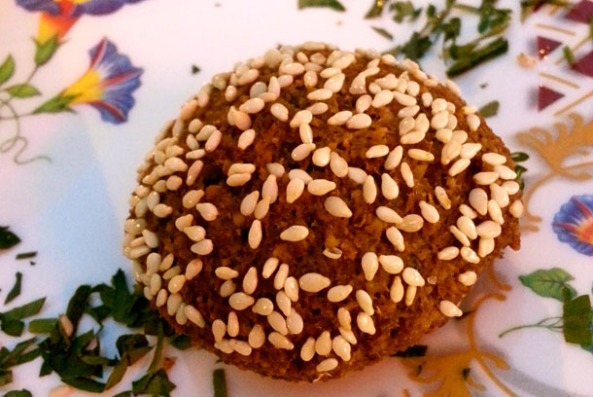
Just like most things in today’s world, there is a controversy regarding the origin of Falafels too. Though it is generally accepted that Falafels have been first made in Egypt, these deep fried crispy chickpea balls have become the most popular Mezze or Starters, as well as a stand alone snack served in Middle Eastern cuisine, all over the Arab world. I’ve learnt to make the Falafel in one of our holidays and I’m quite fascinated with the entire process of Falafel making – scoop the chickpea paste, slap a spoonful onto the contraption of the Falafel maker, unclasp the shaped ball from the contraption, drop the ball into a wok full of oil for deep frying – all in a matter of minutes!
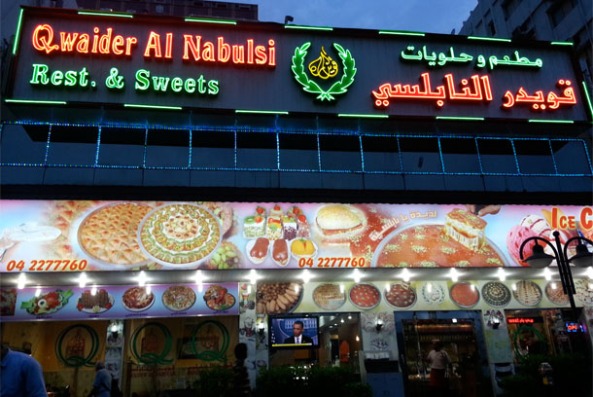
Jordanian Mansaf and Kunafa @Qwaider Al Nablusi
After our foray into the Egyptian Falafels, we were introduced to the Jordanian Mansaf (below) from Qwaider Al Nablusi. Traditionally, a Jordanian and a Palestinian dish, the Mansaf has been described as the national dish of Jordan in recent years. It is cooked in a very special way. The lamb is cooked in a broth of Jameed, a dried up fermented Laban (a very popular Yogurt drink in the Middle East) made from goat’s milk. The cooked lamb is then served on a large platter with a layer of flatbread (Markook or Shrak) topped with rice, then meat, and finally garnished with almonds and pine nuts. As Wiki supplements – The name of the dish comes from the term “large tray” or “large dish”. Mansaf is served on special occasions such as weddings, births and graduations, or to honor a guest, and on major holidays such as Eid ul-Fitr, Eid ul-Adha, Christmas Day, Easter and Jordan’s Independence Day. It is traditionally eaten collectively from a large platter in the Bedouin and rural style, standing around the platter with the left hand behind the back and using the right hand instead of utensils. I was surprised to discover a distinctive smell of Ghee in our Mansaf (it was Mamta who first noticed), and the taste of the lamb was very strong and unusual.
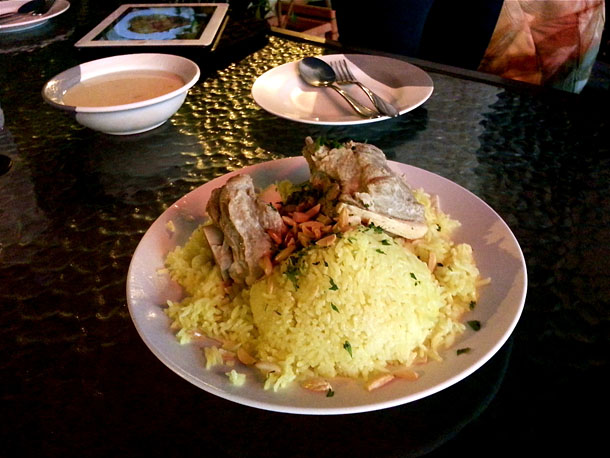
Following the Mansaf, was a super cheesy dessert by the way of Nabulsi Kunafa (below) from Qwaider al Nabulsi. Kunafa is a cheese pastry soaked in sweet syrup. Sounds simple? Probably, but the preparation of the Kunafa doesn’t sound that simple at all. The pastry is heated with butter or palm oil and then spread with soft white Nabulsi cheese and topped with more pastry. A thick syrup of sugar, water, drops of rose water or orange blossom water is poured on the pastry during the final minutes of cooking. The Nabulsi cheese or the Jibneh Nablusi is a white-brine cheese originating from the city of Nablus, situated on the West Bank. Nablus is famed for it’s elite or ‘high cuisine’. It is also famous for Kunafas. In fact, Jibneh Nablusi along with the Akkawi cheese are the most popular cheeses in Jordan. One of the characteristics of the Kunafa cheese – that it becomes soft and elastic when heated, probably lends this awesome dessert its softness and the ultra cheesy feel. I have been craving for Kunafas ever since our food tour and have been wanting to do a Kunafa re-run, but the Kunafa has been evading me in every single Deira visit of mine! Served with sprinklings of crushed green Pistachios, the Kunafa sometimes comes in my dreams. As I was referring to Instagram while I was writing this post, I found an earlier update on the day of our tour – ‘Kunafa replaces my love for chocolates’. How true!
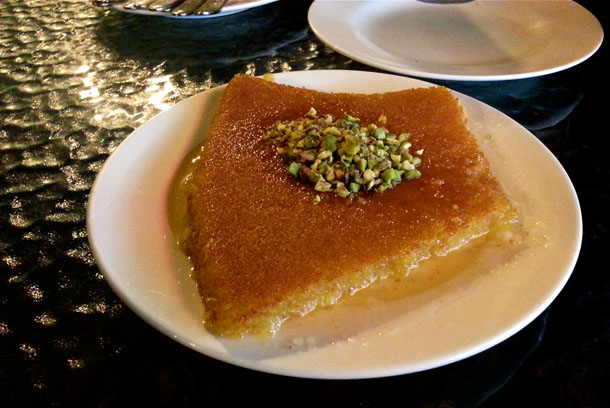
Still on Muraqqabat Road, we now walked towards the Abu Baker Siddique Street (the road that has the Clock Tower, or better still, the road that comes down the Makhtoum Bridge). At the end of our tour, I realised that we had been walking quite a lot, interspersed with a lot of eating. This gave the brain that 20 minute wait signal required to attain food satiety, every time we stopped for our next food tasting. Our next stop was Al Samadi Sweets (further below). I’ve promised myself that the next time I shift houses, I’ll do myself a favour – I’ll take up a house which is within a 200m proximity of the building that houses this sweet shop.
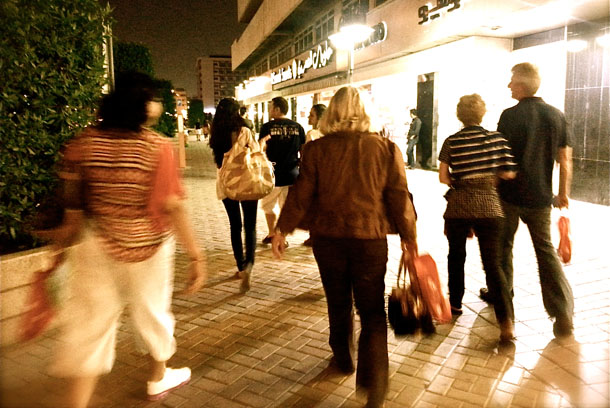
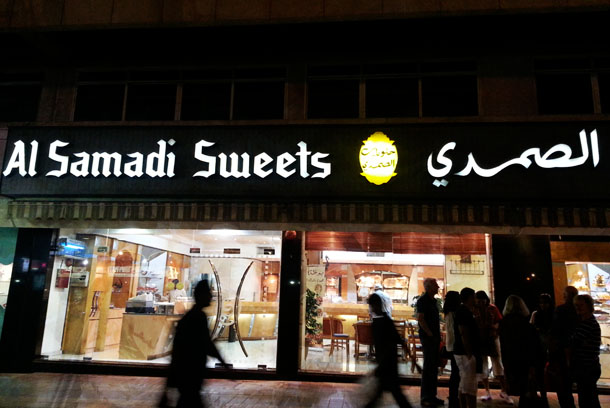
Halawat al Jibn, Karabij, Baklava and Turkish Coffee @Al Samadi Sweets
Huge trays filled with different types of Arabic sweets – Baklavas of different kinds, and thin noodles of Vermicelli studded Kunafa (I could have jumped onto a tray after my date with Kunafa a few minutes back) – Al Samadi Sweets was a sweet loving Bengali foodie’s ultimate dream. After having doused ourselves in strong Turkish coffee and shaking ourselves out of Arva’s magic story telling, we tasted some Arabic sweets – two of which were completely new to me – the Halawat al Jibn and the Karabij. While my taste buds have always welcomed the traditional Baklava, I also came across a few new ones which were not less than any royal treat. Though not my first encounter with these, but I specially love the Bülbül Yuvasi (below). This is a Turkish dessert, a different variant of the Baklava, prepared with baked phyllo dough having a hollow centre. This hollow centre is stuffed with pistachios and resembles the ‘nightingale’s nest’.
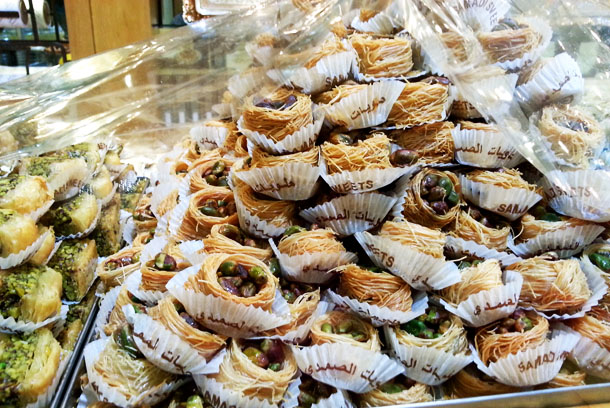
Large pans were filled with the Khishnah Kunafa (below), where the rough crust is made from long thin noodle threads. This Kunafa was largely different from the Na’ama or the fine Kunafa made with the semolina dough that we had tasted earlier. People ate Kunafas in sandwiches for breakfast, stuffing the soft Kunafa inside a bread like a sandwich bag. We were told that by the time it was 10 am, 4-5 large trays of Kunafa were almost gone!
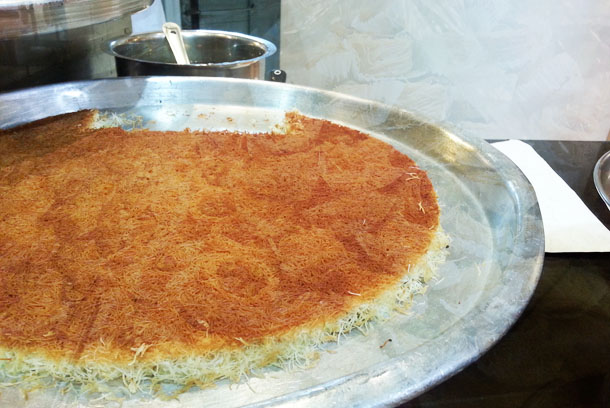
Karabij
Karabij was a Lebanese cookie stuffed with pistachios and served with the Natef cream, a fluffy cream which looks like the Meringue. Arva explained the fascinating way in which the Natef cream was made, complete with a video (on her tablet) of the famous author and writer of Mediterranean cuisine, Anissa Helou demonstrating how to make the Karabij. It’s interesting to know how the Natef is made. It is made from a special root called the Shersh al halawa or the Soapwort Root (Saponaria). The roots are first boiled in water, strained and allow to cool. Then it is whisked for a very long time. As drops of rose water or the orange blossom water is added to this, the surface forms into a foamy white cream – the Natef. I didn’t like the slightly bitter taste of the Natef cream.
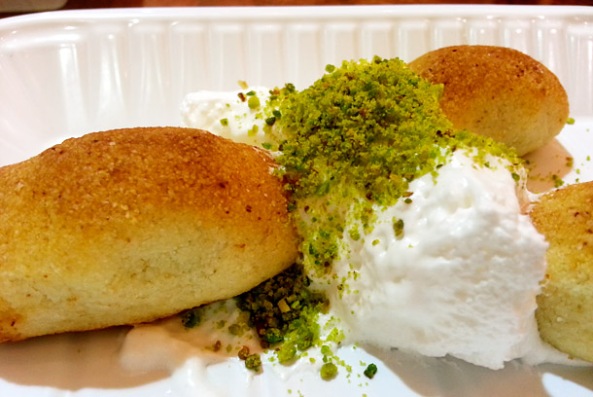
Halawat al Jibn
I have absolutely fallen in love again. This time with the Halawat al Jibn (below). The taste of these desserts remind me of the freshness of Malai Chomchom, a sweet made with cottage cheese or channar mishti that Bengal is so famous for. Served chilled from the fridge (you’ll not find the Halawat al Jibn displayed outside), the taste is out of this world. A thin dough made out of Akkawi cheese and Semolina is first rolled out. Then Ashta, the thick custard like cream that is the basis of most Lebanese pasties, is spread on it, and the dough is rolled into mini cannellonis which are drizzled with sugar syrup and rose water.
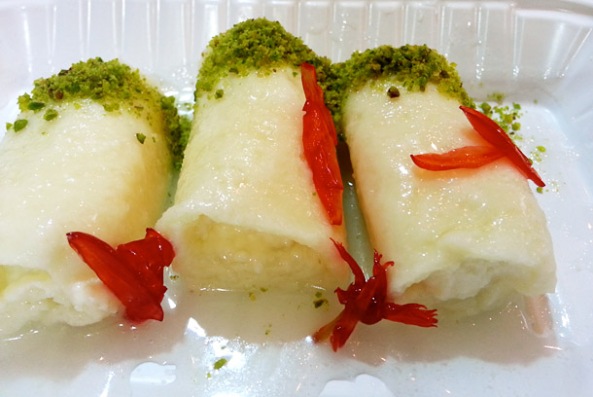
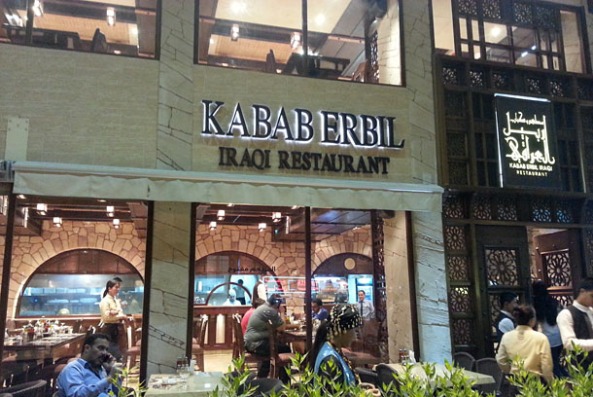
Ogling at the Masqouf @Kabab Erbil
By this time we had walked a lot to reach the Al Rigga Road. While Arva’s posts have introduced me to the Masqouf from another Iraqi restaurant – Bait al Bagdadhi (I promise a post very soon on that), we went inside Kabab Erbil, a new Iraqi restaurant, where we had a glimpse of the fascinating Maqouf being cooked. Considered the National dish of Iraq, this grilled Carp is unique. The fish is cut in two identical halves from the belly up while leaving the back intact, opening up the fish. A marinade is generously brushed inside the fish and then grilled for 3-4 hours, with the fish locked in a standing position (below). This is an experience for sure – but alas, not captured fully in this tour!
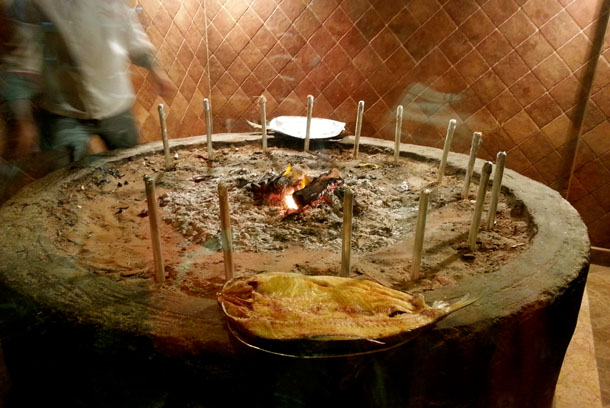
Fateer @Soarikh Restaurant
If you have ever watched Fateer making, you’ll realise why Egyptians are proud of their Fateers. Feteer Meshaltet, Fetir or the Fateer is the Egyptian layered pastry meaning ‘cushion-like pie’ – the stuffing or the filling coming in the form of chicken and cheese, sausage and cheese, tomatoes and olives, cream and honey or traditionally, the simple Kraft Cheese! We tasted the Chicken and Cheese Fateers (below) in the Soarikh Restaurant, after being dazzled by the demonstration of Fateer making – particularly when the cook throws the thin round flattened dough in the air like a Frisbee and catches it untorn and throws it back into the air once again. While the video below shows the traditional Fateer making, my other video on Feteer making demonstrates how Celebrity Chef Joe Barza brings in a few modern twists to the Fateers, in the recently opened Helio Lounge.

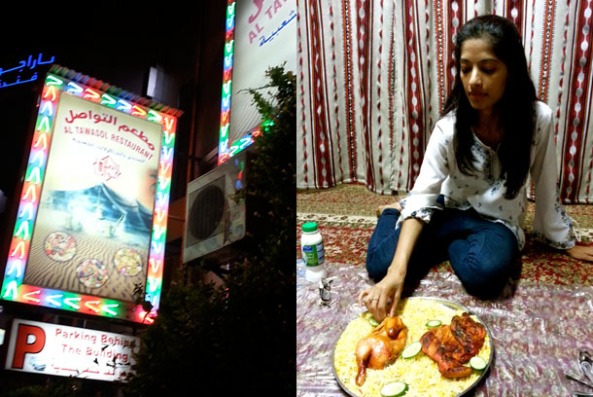
Mandi and Bedouin heritage @Al Tawasol Restaurant
Entering the Al Tawasol Restaurant (just opposite the clock tower) on the busy Abu Baker Sidiqque Street was like entering an Arab world of tents and Bedouin heritage (below). The hankering of horns from the passing cars stuck in the Deira traffic soon faded out as we entered the restaurant. There were curtained rooms that looked like bedouin tents. We entered into a tent after leaving our shoes outside and plopped ourselves on thick large cushions that had been laid out on the carpeted ground. A thin transparent plastic sheet was spread on the carpet by the welcoming waiter, and fresh green salads were served – to be dipped into a really spicy tomato sauce. We were here to taste the Yemeni Mandi. I had heard a lot about the Mandi and this was my first Mandi experience. The Chicken is cooked in the Tanoor or an underground oven and served over yellow rice. This was the Mandi, also known as the Haneeth – a soft and succulent half chicken. Another half of a Chicken was served as the Madhbi or the Mazbi – spiced up like Tandoori Chicken and barbequed. Arva demonstrated how the Mandi was to be eaten. Originating in the Yemeni province of Hadhramaut, this unique dish was to be eaten in the Bedouin style – in the manner of communal eating, to be shared from a single plate. The Mandi was eaten by using fingers (but not exactly in the manner in which we are used to in Indian homes) by clasping a little amount of rice into the palm and making it into a small ball and then smoothly rolling it into the mouth (further below). It was fascinating to watch Arva as she traced out the history of each dish we were tasting. It was also interesting to note the route taken by a dish, beyond it’s place of origin. If I were to choose one Dubai food experience for my guest, it would definitely be a Mandi experience in a restaurant like Al Tawasol.
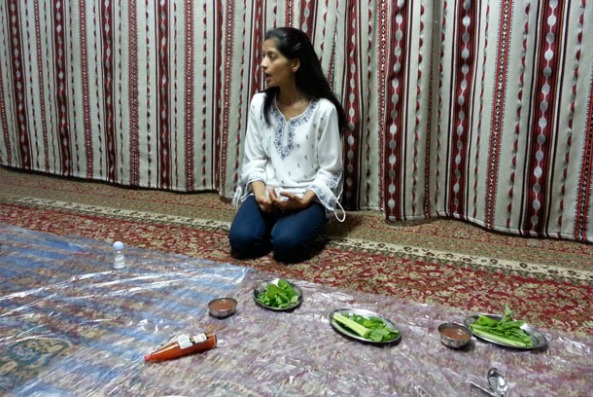
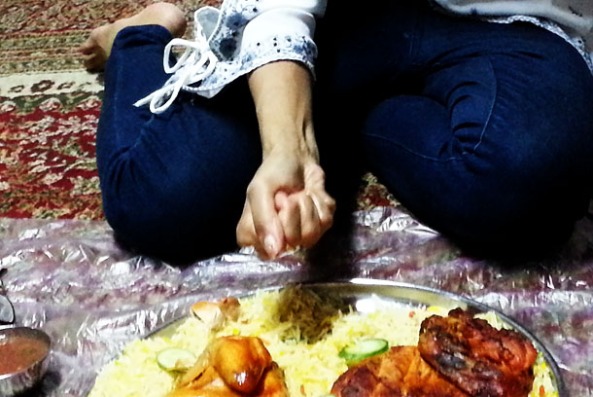
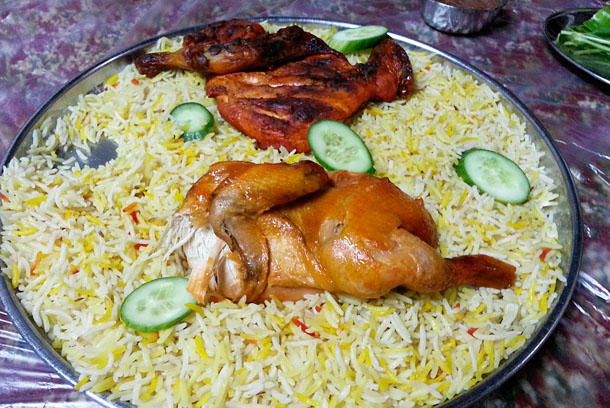
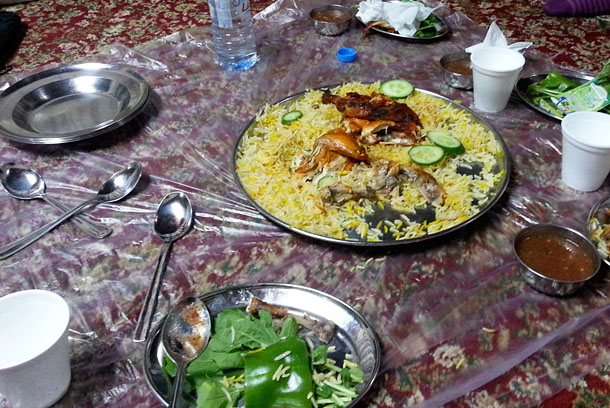
A mini introduction to Arabic spices and nuts came in the way of a small visit to a Spice shop, where a few of our tour members did some souvenir shopping. Well, to have spent almost 3 hours in Dubai without shopping, hadn’t we already committed a bit of sacrilege? It naturally had to be compensated.
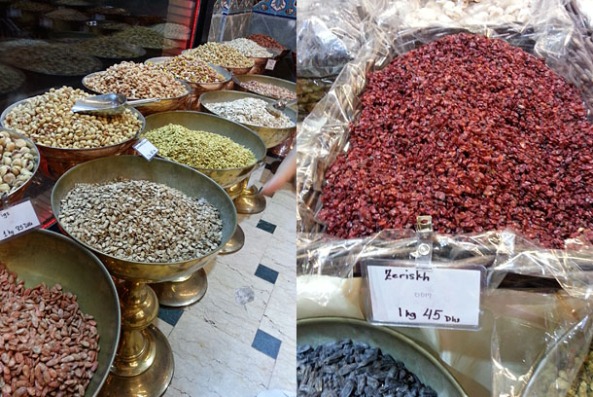
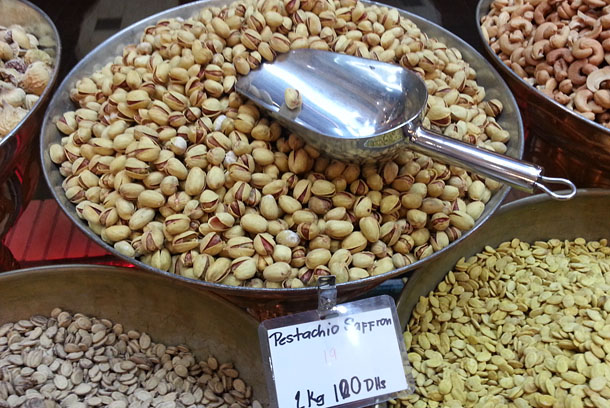
Sangak, Baghali Polo with Lamb, Chicken Kabab, Lamb Koobideh and Iranian sweets @Abshar Restaurant
This was our final stop and by this time it had got pretty late at night. Abshar restaurant didn’t look like a typical restaurant where the decor was diffused in a soft yellow lighting or provided a bit of privacy to its diners. On the contrary, it was housed in an open floor inside a shopping mall. It looked deserted (but then it was very late already). A small group of four men sat close to the stage where a band was playing Iranian folk instruments. The group burst out into emotional screams and clapped out occasionally in delight, probably overjoyed by the lady singer belting out traditional Iranian wedding songs. The stark tube lights exposed not only the heavy make up of the singer but also the neat but not overtly classy decor of the restaurant – huge wooden seating beds (below) covered with Persian carpets and oversized cushions to lean back comfortably while sitting on them. The coldness of the decor and the ambiance was compensated by the warmth of the Iranian dishes that we were served a few minutes later.
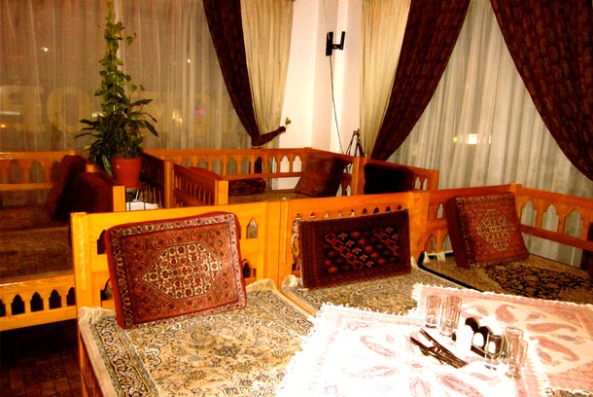
The grand entry of the Baghali Polo with Mahicheh (below), a traditional Iranian dish prepared with fragrant long grained rice and served with soft chunks of tender lamb pieces along with a medium sized lamb shank, melted us completely. Along with the Baghali Polo came a platter of Chicken Kababs and the soft Lamb Koobideh or the Kūbide, an Iranian minced meat kabab which has been made from ground lamb, beef or chicken, often mixed with parsley and chopped onions. Lamb Koobideh is also known as Soltani, meaning the ‘Sultan’s Feast’ and we were indeed having a feast. In Iran, Kababs are considered as a national dish and there are many variations of Kababs. These Iranian delicacies were followed by some Iranian sweets. First came the Jalebi (further below) – very similar to the Indian sweet with the same name. The Iranian Jalebis probably smelt of the rosewater more than their Indian counterpart (or that could be my imagination – Iranian food = rosewater and dried rose petals!). Then came the Bamieh, a fried-dough pastry made of deep fried dough soaked in sugar syrup or honey and cinnamon. These looked like small golden brown sausages but broke into soft syrupy bites as one crunched into them – an Iranian version of the Emirati Lqeimats!
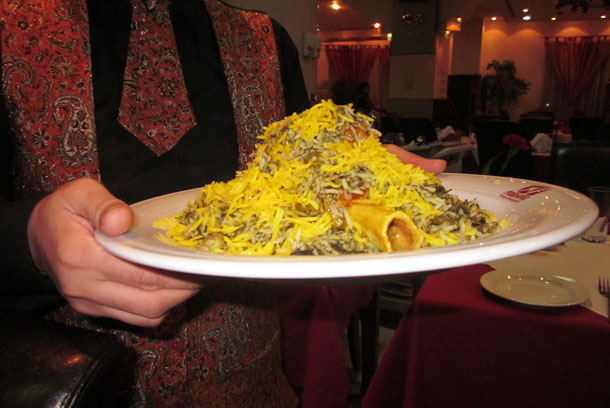
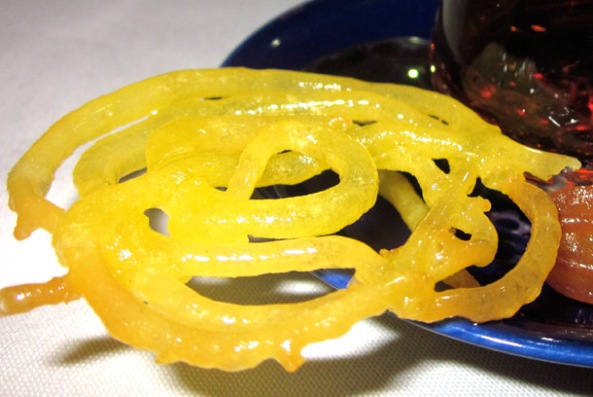
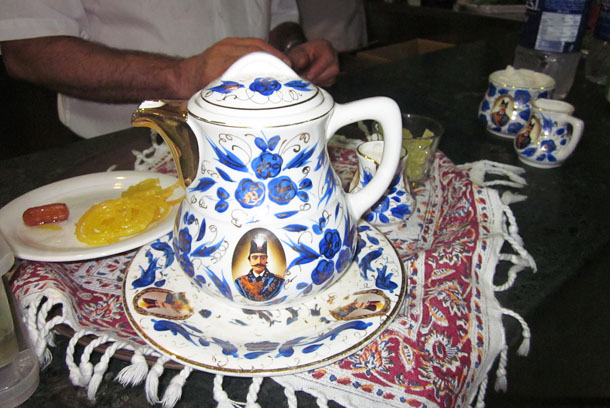
Our tour came to an end as we soaked ourselves into the aroma of Iranian tea, pronounced as Cha-ee. Cha-ee In Iran, is drunk in the morning and after each meal – almost throughout the day. Iranians make tea in their own way and serving the tea in beautiful porcelain tea-sets is as much part of a ritual, as brewing the Iranian tea (I have forever over-romanticized the Iranian tea making – dried up rose petals brewing along with loose tea leaves in an ornate tea pot!).
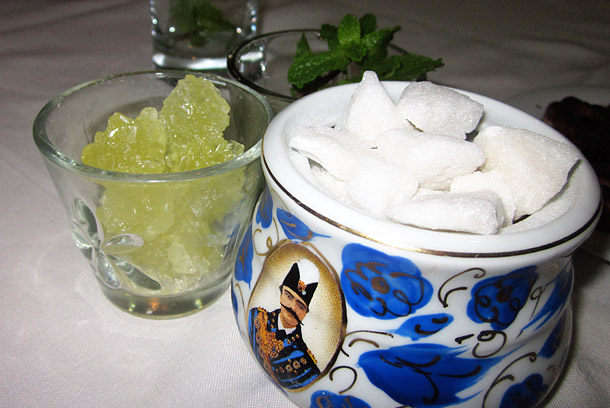
Duration of our tour
As timed precisely by Arva’s stopwatch, our food marathon lasted 4 hours, 23 minutes and 1 second to be precise! A very, very long duration. But worth every second of it and a must do for every foodie. However, I wouldn’t recommend it to families with little children. Generally, the Z-Sizters are always excited with the prospect of any kind of new food, specially restaurant food (where Chefs prepare food!). But the long duration and the frequent walking in between the food stops might not be practical, even for them.
Frying Pan Adventures – Food tours in Dubai
Website, Facebook, Twitter
The tours have been modified for the summers (shortened tours and air-conditioned vehicles to escape the heat) and special Iftar tours are being offered during the Ramadan as well.
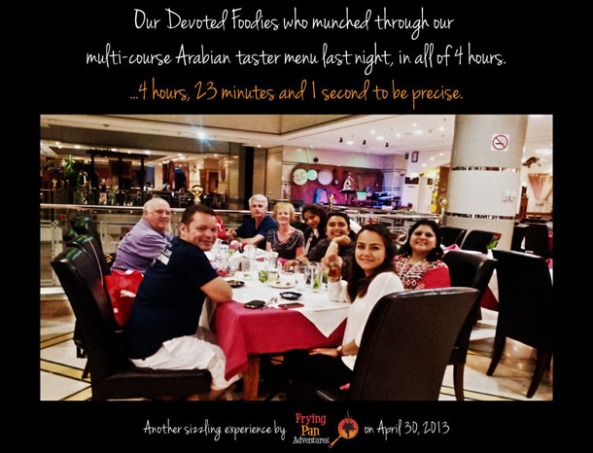
Food transcends border
Food manages to transcend borders and barriers – both geographical and emotional. Egypt may boast of inventing the Falafels, but today they are popular and are a part of any Middle-Eastern cuisine. Variations of the Jordanian Masaf is also eaten in parts of Iraq, Syria and Saudi Arabia. Say, the Kunafa. Also spelt as Knafeh, Kunafeh or Kunafah, it is also popular in Turkey where they are known as the Künefe, though it originated in Nablus. Instead of using the Nablusi cheese here, a semi-soft Mozzarella cheese is used in the filling. A variation of Kadaif is also popular in Greece. The Egyptian Fateers have become Feteers or Fitrs or Fatayers, depending upon which Arabic country it is being eaten in. The Persian Bamieh becomes the Loukoumades in Greece, the lokma tatlısı or simply the Lokma in Turkey, the Lokmades in Cyprus and the Luqmat al-qadi in Arabic. That probably translates into my favourite Emirati sweet – the Lqeimat! The Mandi, originating in Yemen, is now very popular in the rest of the Arabian Peninsula, particularly in Egypt and Syria. No matter where a dish originates, it becomes belongs to a wider region as it becomes popular or as assimilation takes place between different cultures and cuisines. Though the evening took us through a journey into the Middle East via food, in effect, it showed us the world!
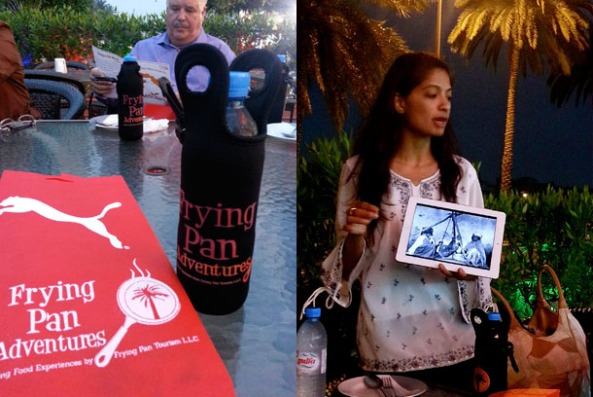
Conclusion: What made the food tour so special apart from the food that’s on offer?
It’s Arva herself. She is passionate about the subject of food, has a lot of knowledge on the origins of different type of dishes that she has selected for tasting in her food tours and the variety that one gets to taste. Starting from the little warm touches of the bottle cooler (I know it sounds weird) and the face wipes that were given to us at the beginning of the tour, to the demonstrations of culinary history on her tablet or through her story telling – she’s here to make you fall in love with the subject that she loves – Food. She didn’t wake up overnight and set up a food tour company. I’m beginning to imagine that these ideas were probably sown slowly and steadily for many years while she was writing about the ‘hole-in-the-wall ethnic eats of old Dubai’ in her blog I live in a Frying Pan. Many of my food blogger friends from Fooderati Arabia had been guinea pigs in her soft runs and initial trials that ultimately led to the design of the food tour packages that you will currently experience.
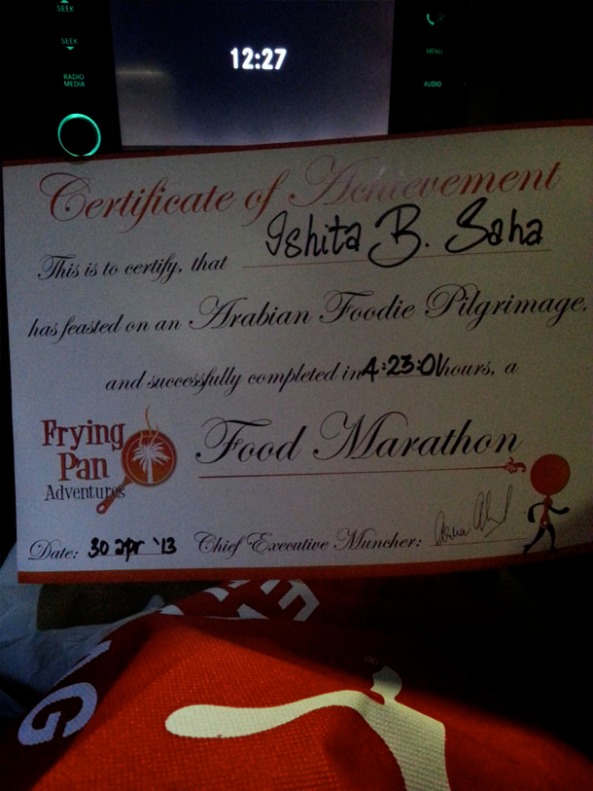
4 hours, 23 minutes and 1 second seemed to zip by in a blink and when I reached home the next day (I parked my car in the garage precisely at 12:27 am the next day), even this seemed short for the Masqouf, or the Koshari or the Hamam Ma’shi that we didn’t get to taste that day. Have you been to any food tour before, in any other city? Have you been to any of the other food tours from Frying Pan Adventures (they also have a North African and Little India food tours)? Do you embark on culinary journeys while holidaying? Talking of food and heritage, my earlier post chalks down all the UNESCO World Heritage sites that I’ve visited so far. And culinary journey brings back memories of my recent Thailand visit. I’ve never ever been so inspired as I’ve been in this trip. And, and, and… before signing off, a reminder on my my blog giveaway – ‘A romantic dinner for two’ from the romantic Thai restaurant Thiptara from The Palace Downtown. The contest closes today midnight!
Unblogging it all… Ishita
Disclaimer: The Arabic Pilgrimage Food Tour cost us Dhs 350/person. The subject, story, opinions and views stated here are my own and are independent. None of the outlets mentioned here have sponsored this post. While you enjoy reading the posts with visuals, please do not use any material from these posts. And do join me on my daily food and travel journey on Instagram, Facebook, Twitter and Pinterest.
◊—————————————————————◊
Posts from Fooderati bloggers on Arva’s tours:
• FooDiva: Savour an ethnic food safari in Dubai
• My Custard Pie: Tour the Middle East via your tastebuds
• My Custard Pie: A tour of North India without leaving Dubai
• Life in the Food Lane: Dubai Food Tour
• D for Delicious: Dubai Last Suppers: Frying Pan Adventures
• Arabic Zeal: Dubai Food Adventure – Tastes of North Africa
• FooDee: Let Frying Pan Adventures take your taste buds on tour
Related posts:
• The Hedonista: A slice of Baghdad in Dubai
• The Hedonista: Fateer, Feteer, Fetir – by any other name, it’s still quite orgasmic


Absolutely loved reading your review, Ishita! Arva’s dedication and knowledge is very, very impressive. Al Tawasol Restaurant is my absolute favorite whenever I crave for mandi.
LikeLike
Thank you so much Nadia for your feedback! There was another that Arva was mentioning – Cabriato (hope I’m spelling it right) in Al Barsha. This was my first mandi experience – unique!
LikeLike
If it’s recommended by you or Arva, then will surely try! Al Barsha, here I come 😀
LikeLike
Another great write up as usual.
1- Knafeh Bil Jibneh
The Palestinian one from Nablous is prepared with Naboulsi Cheese and is only 2 layers with the cheese on the bottom.
The Lebanese one is prepared with Akawi cheese and is made of 2 or 3 layers (with Semolina top and bottom and the cheese in the middle).
You have two variants of Knafeh Bil Jibneh. One uses fine Semolina and the other coarse Semolina. I prefer the coarse Semolina as it has a crunch and the Semolina tends to amalgamate into tiny nuggets which makes it even more delectable.
Very few places in Dubai do the coarse Semolina and the fine Semolina has a sandy consistency which some people like. Samadi uses the fine Semolina.
Add to that 2 other variants as to whether it is cooked with animal or vegetable ghee.
Add to that you have another variant which replaces cheese with Kashta.
I looked at your pic of the Naboulsi Knafeh and it looks as the Semolina layer is thicker than the cheese layer. It is also too much doused in syrup. The Lebanese version is heavier on the cheese…..but I suppose it is subjective taste wise.
Finally, and as I am a fan of Knafeh Bil Jibn, I like to have it served the old way with a small pocket Kaak and as I am pretty vicious when Knafeh bil Jibn is concerned, I double up the Knafeh bil Jibn layer and separate with the top part of another Kaakeh.
So you have one Kaakeh with a serving of Knafhe then a single cover plus another Knafeh serving on top and close with the original Kaak top…….heavily ladden with syrup…..Cholesterol Heaven and Dry Cleaners dream job!
2- Karabeej
Karabeej are of Syrian origin and not Lebanese whatsoever in any shape or form.
The original Karabeej are from Aleppo and the correct name is Karabeej Halab, which translates to Aleppo Karabeej.
Karabij is the plural of Karboujeh which means “cute” as in a cute child. It is a typical Aleppo used word to describe cuteness or sarcastically the lack of it.
Frankly, the Natef is not an easy recipe to make and I am not surprised whatsoever that it was not to your liking.
I looked closely at your pic and this is definitely the wrong Natef. Many substitute egg white and cream and present as Natef.
The Litmus test for Natef is the consistency which should be very close to Toffee. Good Natef is usually heated before serving as it is a palava trying to scoop it with a spoon.as too much sticky.
The Karabeej are also served warm and they come in two variants: Pistachio or Walnuts.
I prefer Walnuts but nobody does them with Walnuts this side of the Creek.
So far, I was never served correct Natef in the Arab and Western World except Aleppo.
3- Halawet El Jibn
I would venture to say it is a Syrian delicacy as it is quite popular in Homs and Aleppo while in Lebanon the city of Tripoli is at the helm of making Halawet El Jibn and Tripoli is close to the Syrian border.
Both the Lebanese and the Syrian are great and they both produce a variant of Halawet El Jibn. If you like the existing Halawet El Jibn, the two Lebanese and Syrian variants will blow your taste buds to culinary heaven!….unfortunately, only one place in Dubai has the Lebanese variant and no place has the Syrian variant….yet!
Thank you.
LikeLike
Thank you:)
LikeLike
OMG your tour looks like so much fun & you got such excellent photos. I can’t wait to do the next one!
LikeLike
I want to do the other tours Holly! But waiting for the weather to cool down a bit. Thanks Holly:)
LikeLike
WOW, what a tour. can only imagine the amount of gobbling and learning you had and eating with foodies is always more fun!
LikeLike
Absolutely well said – eating out is different, but eating out with foodies is another trip altogether. Loved this tour:)
LikeLike
Amazed (and very envious :-)) of the variety of ethnic foods you have access to in Dubai! We love, love, love middle Eastern food and that Kunafa looks worth migrating for! We had some killer ones in Amman and fabulous Feteers – savoury and sweet – in Cairo. Strangely the best Felafel sandwiches I have ever eaten was in Paris, from a hole in the wall shop in the Marais neighbourhood. Looking forward to tasting it again this July 🙂
LikeLike
Thank you Madhu… migrate… I’ll have another travel loving blogger friend living near by. Enjoy Paris and I look forward to seeing all of your quests as you ‘urge on more to wander’! Kunafa – that’s quite a revelation, really.
LikeLike
Pingback: An Iftar Preview in Address Marina | Countdown To Ramadan In Dubai |
A clarification for the small history:
1- Halawet el Jibn is originally from Hama – Syria
2- Knafeh bil Jibn is originally from Nablous – Palestine
LikeLike
Thank you for the info update:)
LikeLike
Pingback: Masqouf in Bait Al Baghdadi | Tasting Iraq’s National Dish |
Pingback: Ramadan in Dubai | Where All You Can Eat |
Pingback: Chicken Kabsa | Recipe From Asateer, The Palm Atlantis |
Pingback: Sumac Octopus with Pomegranate | Recipe From Celebrity Chef Silvena Rowe |
Pingback: Shaabiyat Kacha | Recipe From Address Marina |
Pingback: Day Trips From Dubai During Eid Holidays | Part 1 |
Pingback: Day Trips From Dubai During Eid Holidays | Part 2 |
Pingback: Bu Qtair Fish Restaurant | Capturing A Hidden Gem In Jumeirah. A Video Too! |
Pingback: Sheikh Zayed Mosque or Grand Mosque In Abu Dhabi | A Photo Essay |
Pingback: Entering The World of Emirati Cuisine And Culture | A Photo Essay |
Pingback: The Tastiest Fast Feasts On Earth | Chowzter Awards 2014 Curated By Food Bloggers |
Pingback: The Diary Of A Dubai Resident… As Home Turns Into An Inn! |
Pingback: Ramadan in Dubai | All The Iftar Buffets You Should Should Eat |
Pingback: Ramadan Food Trail With Calcutta Walks | As The Muezzin Calls |
Pingback: Dining Concepts | Dining Around Dubai With Foodiva | IshitaUnblogged
Pingback: Things To Do In Dubai | Like A Tourist In My Own City | IshitaUnblogged
Pingback: Immersing Into The Heart Of Sharjah – Part 1 – IshitaUnblogged
Pingback: When you finally move out of Dubai… which restaurant would you like to visit for one last time?
Pingback: Al Fanar Restaurant & Cafe in Dubai | My First Authentic Emirati Food Experience! – IshitaUnblogged